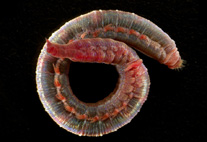Abstract
Thoracophelia (Annelida, Opheliidae) are burrowing deposit feeders generally found in the mid- to upper intertidal areas of sandy beaches. Thoracophelia mucronata (Treadwell, 1914) is found along the west coast of North America, including at Dillon Beach, CA. Two additional species, Thoracophelia dillonensis (Hartman, 1938) and T. williamsi (Hartman, 1938) were also described from this beach. These three sympatric species have been primarily distinguished by branchial morphology, and efforts to determine the validity of the species have been based on morphological, reproductive and ecological studies. Here we demonstrate using mitochondrial and nuclear DNA sequence data that these three species are valid. Mitochondrial Cytochrome c subunit 1 (COI) sequences show uncorrected interspecific distances of ~9–13%. We found no inter—specific differences in body color or in hemoglobin concentration, but found that reproductive males were pinkish-red in color and had lower hemoglobin concentrations than purplish—red reproductive females.
References
Berkeley, E. & Berkeley, C. (1932) On a collection of littoral Polychaeta from the west coast of Vancouver Island. Contributions to Canadian Biology and Fisheries, 7, 311–318. http://dx.doi.org/10.1139/f32-024
Blake, J.A. (2011) Revalidation of the genus Thoracophelia Ehlers, 1897, replacing Euzonus Grube, 1866 (Polychaeta: Opheliidae), junior homonym of Euzonus Menge, 1854 (Arthropoda: Diplopoda), together with a literature summary and updated listing of Thoracophelia species. Zootaxa, 2807, 65–69.
Brewer, M.S., Sierwald, P. & Bond, J.E. (2011) A generic homonym concerning chordeumatid millipedes (Arthropoda: Diplopoda) and ophellid worms (Annelida: Polycheata). Zootaxa, 2744, 65–68.
Carr, C.M., Hardy, S.M., Brown, T.M., Macdonald, T.A. & Hebert, P.D.N. (2011) A tri–oceanic perspective: DNA barcoding reveals geographic structure and cryptic diversity in Canadian polychaetes. PloS One, 6, e22232. http://dx.doi.org/10.1371/journal.pone.0022232
Dafoe, L.T., Gingras, M.K. & Pemberton, S.G. (2008a) Analysis of mineral segregation in Euzonus mucronata burrow structures: One possible method used in the construction of ancient Macaronichnus segregates. Ichnos, 15, 91–102. http://dx.doi.org/10.1080/10420940802016582
Dafoe, L.T., Gingras, M.K. & Pemberton, S.G. (2008b) Determining Euzonus mucronata burrowing rates with application to ancient Macaronichnus segregatis trace–makers. Ichnos, 15, 78–90. http://dx.doi.org/10.1080/10420940802016475
Dangott, L.J. & Terwilliger, R.C. (1986) The role of extracellular hemoglobins in the oxygen consumption of the burrowing polychaete, Euzonus mucronata (Treadwell). Journal of Experimental Marine Biology and Ecology, 97, 196–204. http://dx.doi.org/10.1016/0022-0981(86)90118-8
Ehlers, E. (1897) Polychaeten der Hamburger Magalhaenischen Sammelreise. Ergebn. Hamburg. Magalhaenischen Sammelreise Liefersung, 2, 1–147.
Galtier, N., Nabholz, B., Glémin, S. & Hurst, G.D.D. (2009) Mitochondrial DNA as a marker of molecular diversity: a reappraisal. Molecular Ecology, 18, 4541–4550. http://dx.doi.org/10.1111/j.1365-294X.2009.04380.x
Grube, A.-E. (1866) Eine neue Annelida, zunächst einer nordischen, in der Nähe der Ophelien und Scalibregmen zu stellenden Annelide, Euzonus arcticus. Jahresbericht der Schlesischen Gesellschaf für vaderländische Kultur, Breslau, 43, 64–65.
Hartman, O. (1938) Descriptions of new species and new generic records of polychaetous annelids from California of the families Glyceridae, Eunicidae, Stauronereidae, and Opheliidae. University of California Publications in Zoology, 43, 93–111.
Hartman, O. (1944) Polychaetous annelids from California, including the descriptions of two new genera and nine new species. Allan Hancock Pacific Exped., 10, 239–307.
Hartman, O. (1956) Polychaetous annelids erected by Treadwell, 1891 to 1948. together with a brief chronology. Bulletin of the American Musuem of Natural History, 109, 243–310.
Hartman, O. (1969) Atlas of the sedentariate polychaetous annelids from California. Los Angeles: Allan Hancock Foundation, University of Southern California.
Kemp, P.F. (1986) Direct uptake of detrital carbon by the deposit–feeding polychaete Euzonus mucronata (Treadwell). Journal of Experimental Marine Biology and Ecology, 99, 49–61. http://dx.doi.org/10.1016/0022-0981(86)90020-1
Kemp, P.F. (1988) Production and life history of a deposit–feeding polychaete in an atypical environment. Estuarine, Coastal and Shelf Science, 26, 437–446. http://dx.doi.org/10.1016/0272-7714(88)90024-8
McConnaughey, B.H. & Fox, D.L. (1949) The anatomy and biology of the marine polychaete Thoracophelia mucronata (Treadwell), Opheliidae. University of California Publications in Zoology, 47, 319–340.
Menge, F.A. (1854) Die im Bernstein befindlichen Crustaceen, Myriopoden, Arachniden, und Apteren der Vorvelt. In: G. C. Berendt (Ed), Die im Bernstein befindlichen organischen Reste der Vorwelt, 1(2), pp. 1–123.
Parke, S.R. (1973) Biological aspects of speciation in the three sympatric Euzonus species at Dillon Beach, California (Polychaeta: Opheliidae). MSc. Thesis. Stockton, California: University of the Pacific.
Pleijel, F., Rouse, G.W. & Nygren, A. (2009) Five colour morphs and three new species of Gyptis (Hesionidae, Annelida) under a jetty in Edithburgh, South Australia. Zoologica Scripta, 38, 89–99. http://dx.doi.org/10.1111/j.1463-6409.2008.00356.x
Posada, D. (2008) jModelTest: Phylogenetic model averaging. Mol. Biol. Evol., 25, 1253–1256. http://dx.doi.org/10.1093/molbev/msn083
Rathke, H. (1843) Beiträge zur Fauna Norwegens. Nova Acta der Kaiserlichen Leopold–Carolin Deutschen Akademie der Naturforscher, Halle, 20, 1–264.
Santos, C.S.G., Nonato, E.F. & Petersen, M.E. (2004) Two new species of Opheliidae (Annelida: Polychaeta): Euzonus papillatus sp. n. from a northeastern Brazilian sandy beach and Euzonus mammillatus sp. n. from the continental shelf of south– eastern Brazil. Zootaxa, 478, 1–12.
Stamatakis, A. (2006) RAxML–VI–HPC: Maximum likelihood–based phylogenetic analyses with thousands of taxa and mixed models. Bioinformatics, 22, 2688–2690. http://dx.doi.org/10.1093/bioinformatics/btl446
Swofford, D.L. (2002) PAUP*. Phylogenetic Analysis Using Parsimony (*and Other Methods). Version 4. Sunderland, Massachusetts: Sinauer Associates.
Treadwell, A.L. (1914) Polychaetous annelids of the Pacific Coast in the collections of the Zoological Museum of the University of California. University of California Publications in Zoology, 13, 175–234.

